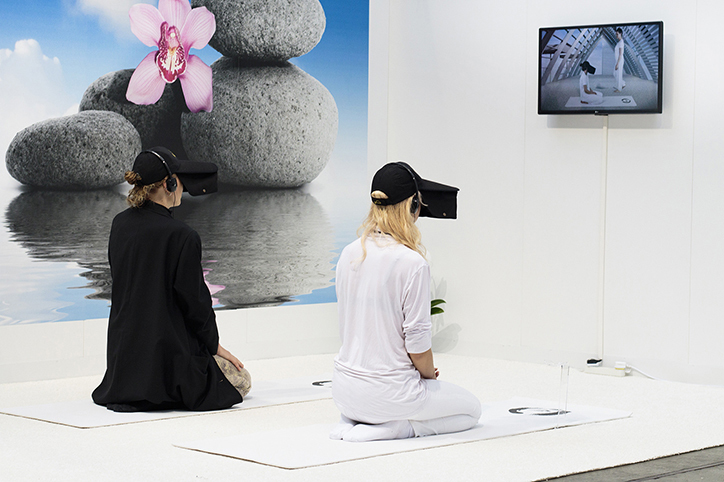Stine Deja has been interviewed and profiled by Daphne Milner for It’s Nice That, where she talks about her relationship to the commodification of mindfulness.
Multimedia artist Stine Deja satirises the commodification of mindfulness
By Daphne Milner
Stine Deja is a Danish multimedia artist who moved to London five years ago to study at the Royal College of Art. Her latest projects, 4K Zen and Cyphoria, are thought-provoking reflections on the relationship between technology and the mind, using videos and interactive installations to engage the viewer.
4K Zen is comprised of two videos. The first resembles an infomercial and stars a woman who stares into the camera as she asks the viewer if they are stressed about things outside of their control. In the background, her doppelgangers perform yoga poses inside a large, futuristic space. Her solution is a hat with a built-in smartphone case that allows the viewer to concentrate on their phone screen. The second is the infomercial’s product: A video of natural landscapes the viewer would screen on their phone to achieve mindfulness. “4K Zen is a stress diet that promises an escape from the complexity of modern life by combining meditation and infomercials. I created it at a time when I felt haunted by bad news politically, societally and environmentally,” Stine Deja tells It’s Nice That. Her video follows the familiar conventions of advertising, but functions as a subtle caricature of a digital culture that transforms bodily and mental well-being into another commodity.
“I was inspired by the over-branding, commercialisation and digitisation of relaxation. You can literally buy everything and I thought it would be interesting to push the idea of commercial wellbeing to the max,” Stine explains. Her idea came to her after she read a study that showed people to be more relaxed when watching television than when sleeping. The 4K Zen hat, which works like a portable darkroom, is symbolic of more than commercialised mental happiness. It also visualises an ideal of wellbeing as one of isolation, where the user escapes into a virtual universe inhabited only by them.
Stine’s interest in the interface between physical bodies and digital spaces is also evident in her earlier project, Cyphoria. In this installation, Stine transfers the audience to “a metaphysical travel agency that offers to transport the viewer beyond their physical body. It’s an experiment in imagining cyberspace as a kind of extended nervous system of the body.” In this way, Stine’s project posits technology as a means to free the mind and liberate the imagination through a person’s withdrawal into a virtual reality. Setting Cyphoria inside a futuristic airport allows Stine to re-invent a familiar setting as an imagined cyberspace, which blurs the boundaries between physical and digital.
The artist’s work can be seen as an extended commentary on digital advancements and the way these changes shape our everyday. Stine’s carefully considered art embraces and explores the nuanced, hotly debated subject of technology’s possible effects. On the one hand, her work illustrates the potential technology has to cure, heal and bring about mental health. On the other hand, her projects satirise the ease and pace with which digital life can become commercialised. “I am excited about technology and its incredible potential to transform the way that we live, but the speed of technological change and how little time we have to evaluate before the next colossal leap is alarming too.”


